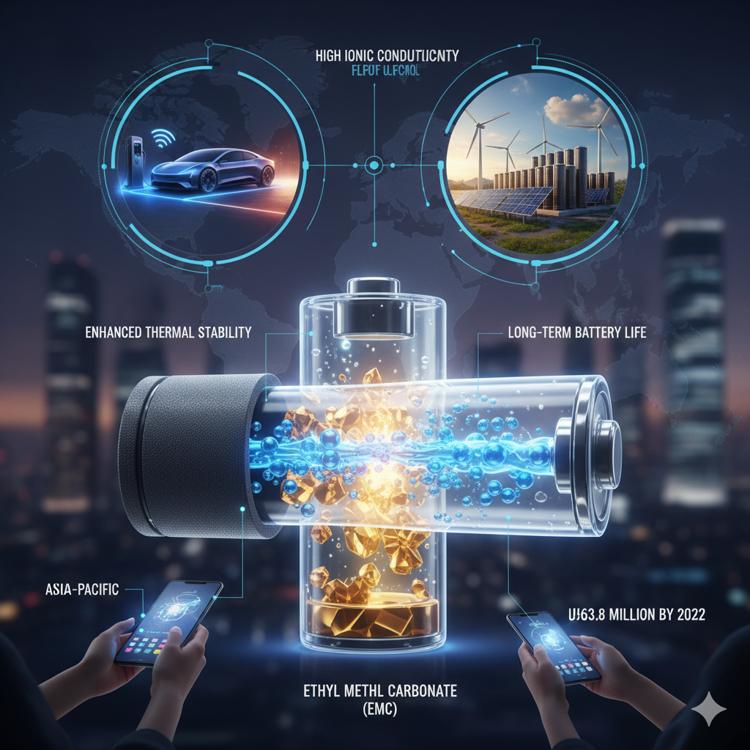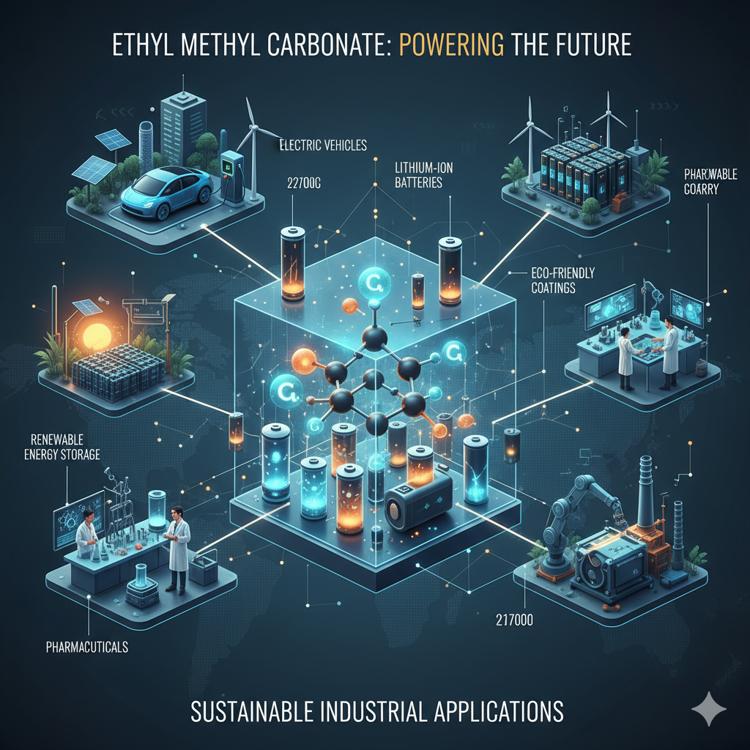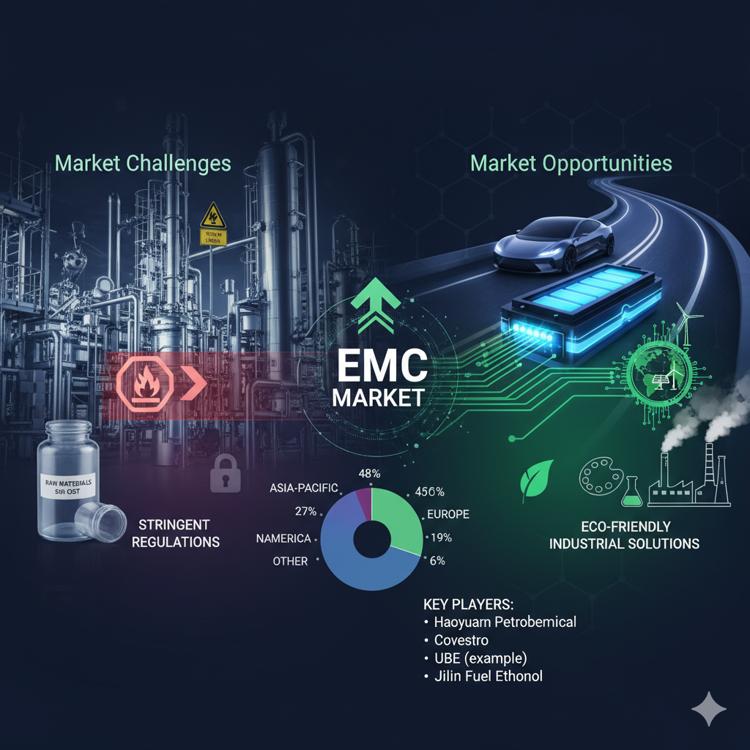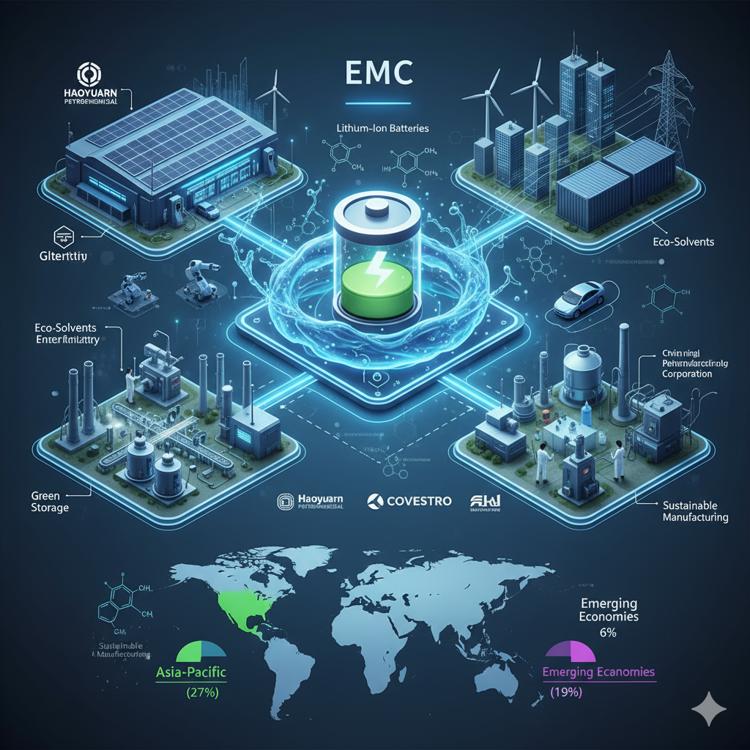Why Is Ethyl Methyl Carbonate Becoming Indispensable for High-Performance Lithium-Ion Batteries?

The global energy landscape is rapidly shifting. With the rise of electric vehicles (EVs), renewable energy storage systems, and portable electronics, the demand for efficient, high-performance lithium-ion batteries has never been greater. Central to this evolution is a little-known yet essential chemical: ethyl methyl carbonate (EMC). Acting as a key electrolyte solvent, EMC plays a pivotal role in enhancing battery performance, safety, and longevity. This article explores why EMC is becoming indispensable for lithium-ion batteries and how its market is poised for substantial growth over the coming decade. Acoording to Credenceresearch The ethyl methyl carbonate market size was valued at USD 304.5 million in 2024 and is anticipated to reach USD 463.8 million by 2032, at a CAGR of 5.4 % during the forecast period (2024-2032).
Understanding Ethyl Methyl Carbonate
Ethyl methyl carbonate is an organic carbonate solvent widely used in lithium-ion battery electrolytes. Its chemical structure provides a unique combination of low viscosity and high ionic conductivity, making it ideal for use in high-energy-density batteries. Unlike many other solvents, EMC ensures that lithium ions can move efficiently between the battery’s electrodes, minimizing internal resistance and maximizing power output.
Beyond batteries, EMC is also finding applications in paints, coatings, and pharmaceuticals, thanks to its eco-friendly properties and effectiveness as a solvent. However, its role in lithium-ion batteries remains the most critical driver of market growth.
The Role of EMC in Lithium-Ion Batteries
Lithium-ion batteries consist of three key components: the cathode, anode, and electrolyte. The electrolyte is the medium that allows lithium ions to shuttle between the cathode and anode during charging and discharging. Without a highly efficient electrolyte, battery performance would be significantly compromised.
EMC contributes to lithium-ion batteries in several ways:
- High Ionic Conductivity
EMC allows lithium ions to move rapidly between the electrodes, ensuring consistent energy delivery. This is particularly critical for applications that require rapid charging and high power output, such as EVs. - Low Viscosity
The low viscosity of EMC facilitates easier ion transport, reducing internal resistance and improving the battery’s overall efficiency. - Enhanced Thermal Stability
Batteries generate heat during operation, and EMC provides excellent thermal stability, minimizing the risk of thermal runaway and improving safety. - Compatibility with Other Solvents
EMC is often blended with other carbonate solvents like dimethyl carbonate (DMC) and ethylene carbonate (EC) to optimize electrolyte performance. This flexibility allows manufacturers to tailor electrolyte formulations for specific battery types and applications. - Long-Term Battery Life
By maintaining efficient ion transport and reducing side reactions, EMC contributes to longer battery life, a key consideration for both consumer electronics and electric vehicles.
Source: https://www.credenceresearch.com/report/ethyl-methyl-carbonate-market
Market Drivers for Ethyl Methyl Carbonate
The EMC market is witnessing robust growth, driven primarily by the booming lithium-ion battery sector. According to industry reports, the market was valued at USD 304.5 million in 2024 and is projected to reach USD 463.8 million by 2032, growing at a CAGR of 5.4%. Several factors underpin this growth:
1. Rising Demand for Electric Vehicles
Electric vehicles are the largest single driver of EMC demand. Countries worldwide are implementing aggressive policies to phase out internal combustion engines in favor of EVs. For instance, China, the United States, and European nations are investing heavily in EV infrastructure, including battery manufacturing facilities.
Lithium-ion batteries are the heart of EVs, and EMC’s role as a high-performance electrolyte solvent makes it indispensable. Its ability to support high energy density and rapid charging directly aligns with consumer expectations for long-range, fast-charging electric vehicles.
2. Growth in Renewable Energy Storage
The global shift toward renewable energy has also spurred demand for large-scale energy storage systems. Solar and wind power are inherently intermittent, making efficient battery storage crucial for grid stability. EMC-based lithium-ion batteries are preferred in these systems because of their high performance, reliability, and scalability.
3. Advancements in Portable Electronics
EMC is not limited to EVs and grid storage. It also plays a critical role in smartphones, laptops, tablets, and wearable devices. As consumers demand thinner, lighter, and longer-lasting devices, EMC enables battery designs that meet these stringent performance criteria.
4. Diversification into Industrial Applications
Beyond batteries, EMC’s use in paints, coatings, and pharmaceuticals further supports market expansion. The trend toward eco-friendly solvents is gaining traction, and EMC’s lower environmental impact makes it an attractive alternative to traditional solvents.
Regional Insights: Why Asia-Pacific Leads
Asia-Pacific dominates the EMC market, accounting for nearly 48% of global demand in 2024. Several factors contribute to this regional leadership:
- China, Japan, and South Korea are home to some of the world’s largest battery manufacturers, producing lithium-ion cells at scale for EVs and electronics.
- Strong government incentives and policies promoting EV adoption accelerate EMC demand.
- Well-established chemical manufacturing infrastructure ensures efficient production and supply chain integration.
North America follows with 27% market share, driven by the United States’ EV boom and renewable energy initiatives. Europe accounts for 19%, supported by stringent environmental regulations and investments in sustainable energy systems. Emerging markets in Latin America and the Middle East & Africa are gradually increasing adoption as industrial applications expand.
Challenges in the EMC Market
Despite its growing importance, the EMC market faces several challenges:
- High Production Costs
EMC is relatively expensive to produce, and the market is sensitive to fluctuations in raw material prices. This creates challenges for smaller producers attempting to compete with large, established chemical manufacturers. - Supply Chain Vulnerabilities
Disruptions in the supply of raw materials, such as methyl and ethyl carbonates, can affect production and pricing, especially in regions dependent on imports. - Environmental and Regulatory Pressures
While EMC is considered eco-friendly compared to traditional solvents, strict environmental regulations on chemical manufacturing and handling can add compliance costs and operational complexities. - Intense Market Competition
The market is highly competitive, with major players such as Ube Industries, Mitsubishi Chemical, Lianyungang Lida, and others investing heavily in R&D to improve performance and reduce costs. Smaller companies must innovate continuously to remain viable.
Technological Innovations Boosting EMC Demand
Ongoing research in advanced lithium-ion and next-generation battery technologies is a key factor supporting EMC adoption:
- High-Voltage Batteries: EMC can withstand higher voltages, making it ideal for next-generation EV batteries that aim to extend driving ranges.
- Fast-Charging Technologies: Battery chemistries optimized with EMC allow rapid charging without compromising safety.
- Solid-State Battery Research: While solid-state batteries aim to replace liquid electrolytes, EMC remains crucial in hybrid approaches during the transition period.
Manufacturers are also experimenting with blended electrolyte systems incorporating EMC to achieve superior cycle stability, lower internal resistance, and enhanced low-temperature performance.
Future Outlook: A Market Poised for Growth
The EMC market is expected to witness steady growth through 2032, driven by the following trends:
- Expansion of EV Production Worldwide
As EV adoption grows, particularly in Europe and North America, EMC demand will rise proportionally. Battery manufacturers are seeking high-performance electrolytes to meet consumer expectations for long range, rapid charging, and safety. - Growth in Energy Storage Solutions
Utilities and commercial entities are increasingly investing in large-scale lithium-ion storage systems. EMC-based electrolytes will remain a key component of these systems. - R&D in High-Performance Batteries
Continuous innovation in battery chemistries, such as high-nickel cathodes and silicon anodes, is increasing reliance on EMC for optimal electrolyte performance. - Emerging Industrial Applications
Beyond batteries, EMC’s versatility in coatings, paints, and pharmaceuticals will support secondary growth avenues, especially as industries seek safer, environmentally friendly solvents. - Geographic Diversification
While Asia-Pacific remains the dominant market, North America and Europe are catching up due to increased EV penetration, renewable energy storage adoption, and sustainability regulations.

Ethyl Methyl Carbonate Market: Challenges, Opportunities, and Regional Insights
The global ethyl methyl carbonate (EMC) market is witnessing strong momentum driven by rising demand for lithium-ion batteries, eco-friendly industrial applications, and energy storage solutions. However, like any specialized chemical market, EMC faces challenges that affect production, distribution, and adoption. This article provides a comprehensive list-based analysis of market challenges, opportunities, segmentations, and regional dynamics, highlighting why EMC remains critical in modern industries.
Market Challenges
- High Production Costs and Limited Raw Material Availability
- EMC production requires specialized infrastructure and processing techniques, making it capital-intensive.
- Sourcing raw materials can be difficult, leading to price volatility and reduced profit margins for smaller manufacturers.
- Limited feedstock availability restricts entry for new players, giving established companies a competitive edge through economies of scale.
- Price sensitivity in certain markets may slow adoption despite strong demand from EVs and industrial applications.
- Safety Concerns and Stringent Regulatory Compliance
- EMC is a flammable solvent, requiring careful handling during production, storage, and transport.
- Compliance with environmental and safety regulations increases operational costs, especially for companies operating across multiple regions.
- Potential health risks create hesitation among some end-users, impacting market penetration.
- Manufacturers must invest in safety protocols and certification processes, which can challenge smaller producers.
Market Opportunities
- Expanding Role in Energy Storage and Electric Vehicles
- EMC is a critical solvent in advanced lithium-ion batteries, improving conductivity and ensuring safe, efficient charge-discharge cycles.
- Global EV adoption and renewable energy storage systems create long-term, stable demand for high-performance battery electrolytes.
- Government incentives and stricter emission reduction policies further encourage growth.
- Large-scale investments in gigafactories and energy storage projects enhance market stability and future potential.
- Emerging Applications in Eco-Friendly Industrial Solutions
- EMC is increasingly used in paints, coatings, and pharmaceuticals, replacing volatile organic compounds.
- Regulatory shifts toward green manufacturing open new avenues for adoption across developed and emerging markets.
- Growing focus on safer workplace practices drives adoption, aligning performance with environmental and safety compliance.
- Companies investing in sustainable transformation are fueling broader industrial use of EMC.
Market Segmentation Analysis
By Technology
- Transesterification
- Dominates the market due to its efficiency and scalability.
- Widely adopted for commercial EMC production.
- Example: Researchers at Fuzhou University used a lipophilic acid-base bifunctional catalyst ([DBU+][IM-]@UiO-66-NDC(50)) to achieve a 62.5% yield at 108.7°C with 9.7 wt% catalyst, enhancing production efficiency for lithium-ion battery electrolytes.
- Direct Carbonylation
- Gaining traction for its ability to produce higher yields with fewer by-products.
- Represents a cleaner and more cost-effective alternative for future industrial applications.
- Increased research in sustainable synthesis technologies supports its growth.
By Application
- Lithium-Ion Battery Electrolytes
- EMC’s low viscosity and high conductivity make it essential for EVs and energy storage.
- Paints and Coatings
- Used as a green solvent, replacing traditional VOC-based chemicals.
- Pharmaceuticals
- EMC provides safe, high-purity solvent options for formulations.
- Chemical Processing
- Offers safer alternatives to hazardous solvents, supporting regulatory compliance.
Example: UBE’s high-purity EMC solvent delivers 99.0% assay purity, moisture ≤0.01%, and methanol ≤0.01%, meeting rigorous green chemistry standards.
By Distribution Channel
- Direct Sales
- Dominates due to strong partnerships between manufacturers and end-users.
- Ensures consistent supply and quality control, especially for batteries and chemical industries.
- Distributors
- Support market expansion in smaller or emerging regions.
- Complements direct sales by improving regional accessibility.
By Region
- Asia-Pacific
- Holds 48% market share in 2024, leading global adoption.
- Strong demand from China, Japan, and South Korea for EV and energy storage battery production.
- Government incentives, established supply chains, and rapid industrial growth across Southeast Asia support steady adoption.
- North America
- Accounts for 27% market share.
- Driven by EV penetration, renewable energy projects, and investments in gigafactories.
- Adoption supported across the U.S. and Canada due to regulatory policies promoting clean energy.
- Europe
- Captures 19% market share.
- Strict environmental regulations and sustainability targets encourage green solvent adoption.
- Widely used in paints, coatings, and pharmaceuticals across Germany, France, and the UK.
- Investments in EV infrastructure and renewable energy storage reinforce regional demand.
Key Players in the Ethyl Methyl Carbonate Market
- Haoyuan Petrochemical
- Hangzhou Dayangchem Co., Ltd.
- Shandong Jiahua Energy Technology Co., Ltd.
- Covestro
- Alterity
- China National Petroleum Corporation
- Shandong Ruiyang Petrochemical Co., Ltd.
- Zibo Qixiang
- TCI
- Kishi
- Acros Organics
- Jilin Fuel Ethanol
- Shanghai Haiwang Petrochemical Technology
These companies focus on large-scale production, R&D, and sustainable manufacturing, ensuring EMC meets rising global demand across EVs, industrial applications, and renewable energy storage.

How Is Competition Shaping the Future of the Ethyl Methyl Carbonate Market?
The ethyl methyl carbonate (EMC) market is evolving rapidly, driven by the surging demand for lithium-ion batteries, eco-friendly solvents, and large-scale energy storage systems. Amidst this growth, competition plays a crucial role in shaping innovation, production efficiency, and market expansion. This article explores the competitive landscape, recent developments, and future opportunities for EMC through a series of insightful questions, providing clarity for investors, manufacturers, and industrial stakeholders.
Who Are the Key Players Driving the EMC Market?
The EMC market is characterized by a mix of global and regional companies competing for market share through innovation, quality, and strategic partnerships. Leading players include:
- Haoyuan Petrochemical
- Hangzhou Dayangchem Co., Ltd.
- Shandong Jiahua Energy Technology Co., Ltd.
- Covestro
- Alterity
- China National Petroleum Corporation
These companies compete on multiple fronts: large-scale production capacity, product quality, and strong collaborations with battery and chemical manufacturers. Their strategies include vertical integration, ensuring stable access to raw materials and minimizing production risks. Additionally, technological advancements in synthesis methods enable more efficient and sustainable EMC production, helping maintain competitive advantages.
How Are Companies Innovating to Stay Competitive?
Innovation is at the heart of EMC market competitiveness. Leading companies are focusing on:
- Advancing Synthesis Technologies
- Improvements in transesterification and carbonylation methods enhance production efficiency and sustainability.
- Cleaner, cost-effective processes allow companies to meet growing demand without compromising environmental compliance.
- Expanding Product Portfolios
- Covestro, for instance, expanded its specialty adhesive films portfolio through the acquisition of Pontacol AG in August 2025, highlighting the emphasis on diversification and sustainable growth.
- Strategic Partnerships
- Collaborations between chemical producers and battery manufacturers ensure tailored solutions for high-performance lithium-ion batteries, creating long-term market stability.
- Global Market Penetration
- Expansion into emerging markets strengthens positions in regions experiencing industrialization and energy transition, particularly in Asia-Pacific.
What Recent Developments Highlight Market Momentum?
The EMC market has witnessed several notable developments reflecting its dynamic nature:
- Anhui Haoyuan Chemical Group (August 2025): Partnered with Casale to launch a new melamine production plant using sustainable uLEM-N technology, with a 60,000-ton annual capacity.
- Shandong Province (July 2025): Approved 18.6 GW of new energy storage projects, supporting innovative technologies and regional EMC demand.
- Covestro (August 2025): Completed the Pontacol AG acquisition, reinforcing its sustainable growth initiatives.
These milestones underscore the synergy between innovation, regulatory support, and industrial expansion, highlighting EMC’s growing relevance across multiple sectors.
How Is Competition Influenced by Regulatory Compliance?
Regulatory frameworks significantly shape competition in the EMC market. Key considerations include:
- Safety Standards
- EMC is a flammable solvent, and companies must adhere to strict production, storage, and transportation guidelines.
- Established players benefit from experience and infrastructure to comply efficiently, while smaller entrants may face higher operational costs.
- Environmental Compliance
- Regulations on volatile organic compounds (VOCs) and emissions favor EMC as a greener alternative, but meeting compliance standards requires investment in safety protocols and certification.
- Global distribution networks and adherence to local regulations give leading companies a competitive edge.
- Global Market Access
- Compliance with multi-region regulations facilitates international expansion and partnerships, ensuring steady market presence.
What Market Segments Are Driving Growth?
The EMC market is segmented across technology, application, distribution channels, and regions, each contributing to growth:
By Technology
- Transesterification: Dominates due to scalability and efficiency in commercial production.
- Direct Carbonylation: Gaining momentum for higher yields with fewer by-products; increasingly relevant for sustainable production initiatives.
By Application
- Lithium-Ion Battery Electrolytes: EMC’s low viscosity and high conductivity make it essential for EVs and energy storage.
- Paints and Coatings: Eco-friendly solvent adoption supports compliance with emission regulations.
- Pharmaceuticals: EMC provides high-purity, safe solvent solutions.
- Chemical Processing: Replaces hazardous traditional solvents, aligning with green chemistry initiatives.
By Distribution Channel
- Direct Sales: Predominates due to strong manufacturer-end user partnerships, ensuring quality and supply consistency.
- Distributors: Expand reach in smaller and emerging markets, complementing direct sales strategies.
Which Regions Are Leading EMC Adoption?
Asia-Pacific
- 48% market share in 2024, driven by China, Japan, and South Korea.
- Dominance stems from large-scale battery production, EV infrastructure, and clean energy investments.
- Southeast Asia’s industrial growth and manufacturing capacity further fuel EMC demand.
North America
- 27% market share, supported by EV penetration and renewable energy integration.
- Investments in gigafactories and energy storage projects strengthen the region’s market position.
Europe
- 19% market share, reinforced by strict environmental regulations and sustainability initiatives.
- Widespread adoption in paints, coatings, and pharmaceuticals aligns with the European Green Deal objectives.
Emerging economies in Latin America, the Middle East, and Africa are gradually expanding EMC adoption due to industrialization and energy transition efforts.
What Is the Future Outlook for the EMC Market?
The EMC market is poised for continued growth and innovation, supported by:
- Electric Vehicle Expansion
- Rapid global adoption of EVs will sustain strong demand for high-performance lithium-ion battery electrolytes.
- Large-Scale Energy Storage
- Adoption of renewable energy solutions requires reliable battery technologies, further supporting EMC use.
- Eco-Friendly Industrial Applications
- Paints, coatings, and pharmaceuticals will continue to shift toward safer, greener solvents.
- Government Incentives
- Policies promoting green technologies and sustainable manufacturing encourage EMC adoption.
- Technological Advancements
- Innovations in electrolyte formulations enhance battery safety, efficiency, and cycle life.
- Investment in Production Facilities
- Rising global demand drives capacity expansion, particularly in Asia-Pacific and Europe.
- Strategic Partnerships
- Collaborations between chemical producers and battery manufacturers will unlock new growth opportunities.
- Emerging Market Adoption
- Industrialization and energy transition in developing economies will further strengthen market growth.

Conclusion
The ethyl methyl carbonate (EMC) market is poised for significant growth, driven by the escalating demand for electric vehicles (EVs) and the global shift towards sustainable energy solutions. As a critical component in lithium-ion battery electrolytes, EMC's role in enhancing battery performance positions it at the forefront of the clean energy transition.
However, the market faces challenges, including high production costs, limited raw material availability, and stringent regulatory compliance requirements. These factors necessitate ongoing innovation and strategic partnerships to ensure a stable supply and adherence to safety standards.
Looking ahead, the EMC market is expected to expand across various applications, including paints, coatings, and pharmaceuticals, as industries increasingly adopt eco-friendly solvents. Regional dynamics, particularly in Asia-Pacific, North America, and Europe, will continue to influence market trajectories, with each region contributing uniquely to global demand and innovation.
In summary, while the EMC market presents promising opportunities, stakeholders must navigate the complexities of production, regulation, and market dynamics to capitalize on its full potential.
Source: https://www.credenceresearch.com/report/ethyl-methyl-carbonate-market
- Business
- Research
- Energy
- Art
- Causes
- Tech
- Crafts
- crypto
- Dance
- Drinks
- Film
- Fitness
- Food
- Games
- Gardening
- Health
- Home
- Literature
- Music
- Networking
- Other
- Party
- Religion
- Shopping
- Sports
- Theater
- Wellness


